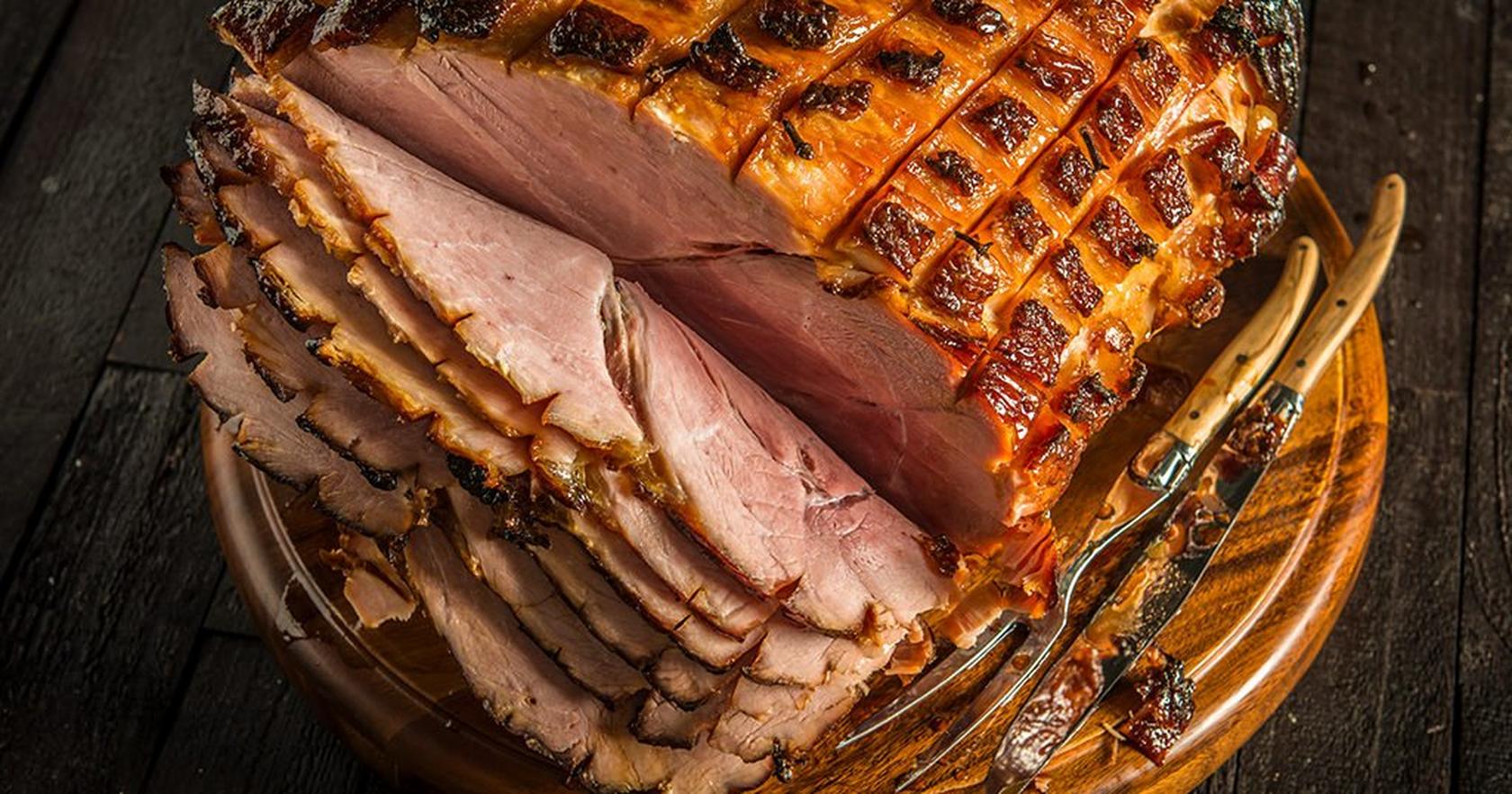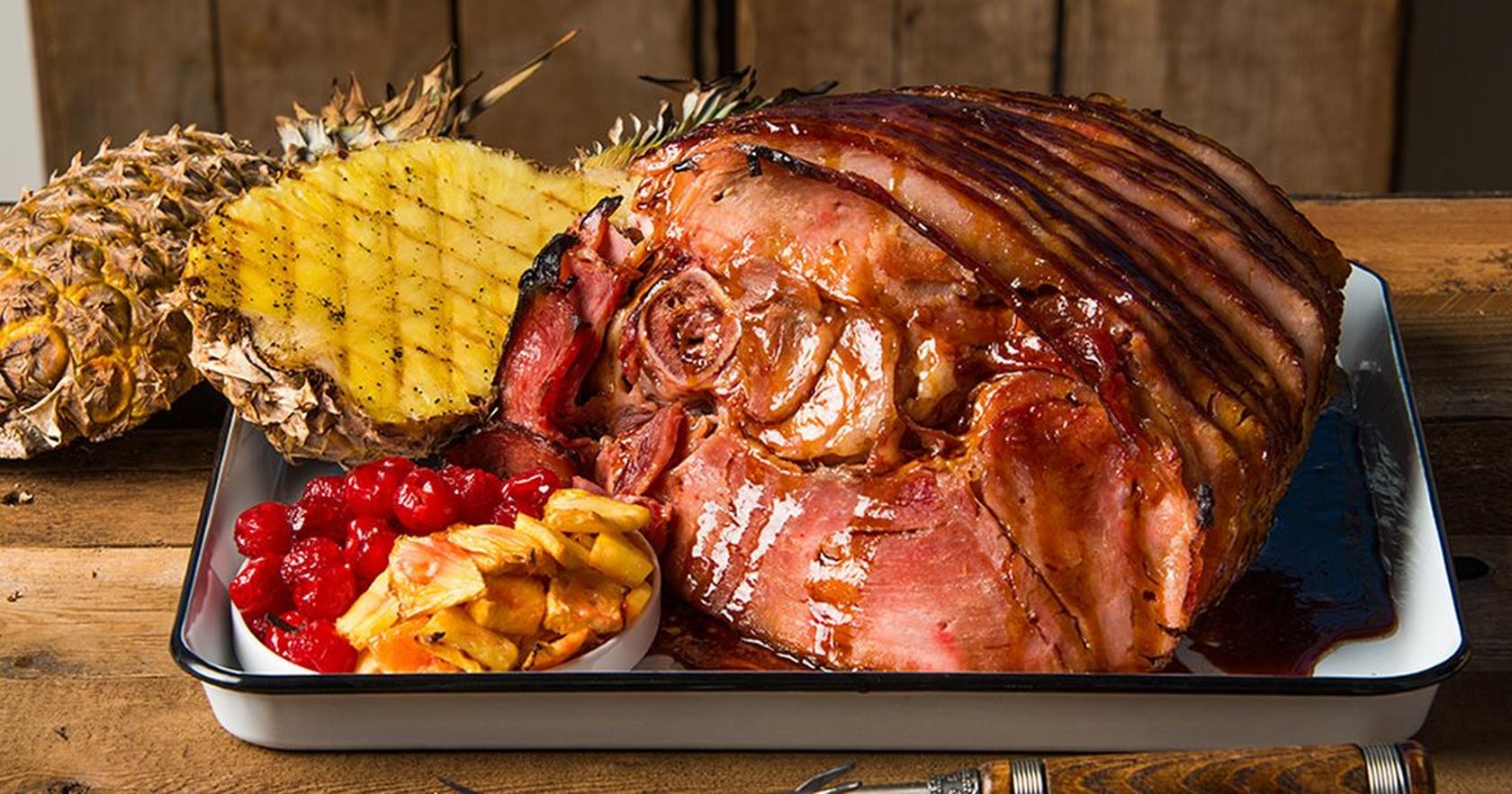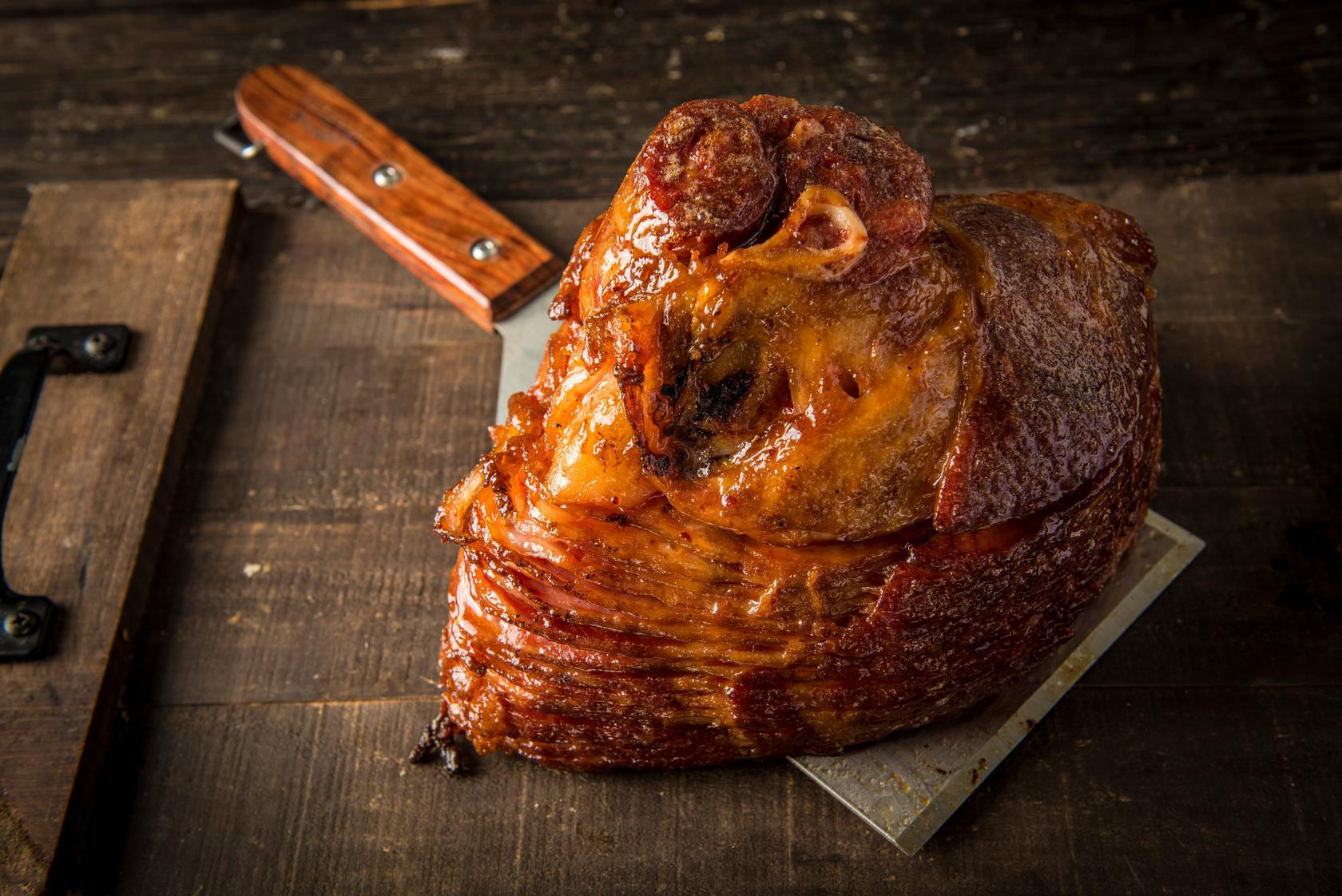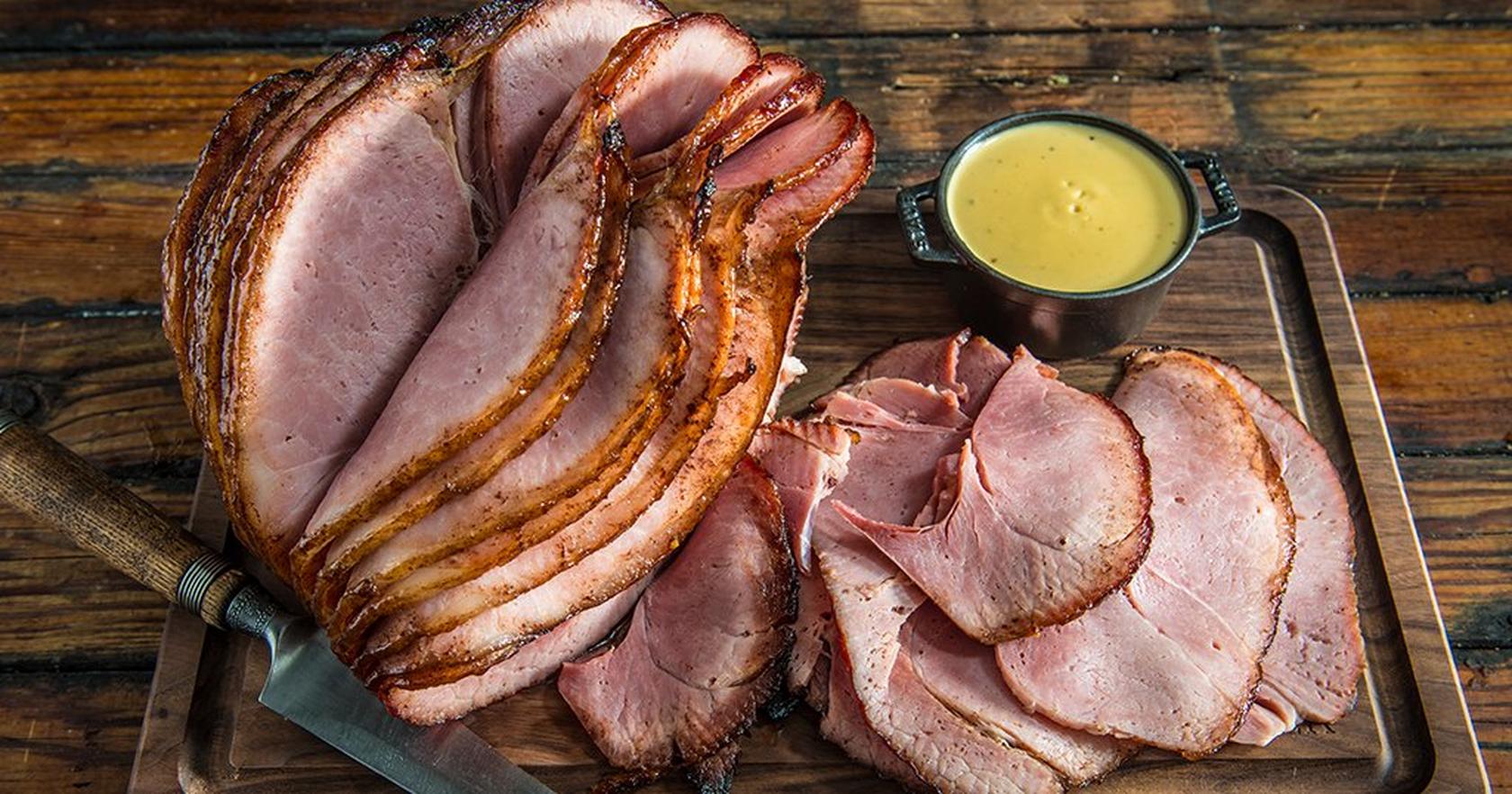
If you're thinking of smoking a ham, this is your sign to do it. Smoked ham is a culinary favorite and graces many holiday tables for good reason. When you choose to go through the process of smoking a ham on the pellet grill, this delicious meat goes from a classic to a work of art.
Tinged pink from curing, the meat has been brined and smoked to create that telltale sweet, smoky, and slightly salty flavor we all love. For how to smoke (or in most cases, double-smoke) a ham, read on.
What Is Smoked Ham?
Smoked ham is simple. Known for its savory flavor and smoky wood-fired flavor, smoked ham is a cut of pork from the hind leg that has been seasoned and cooked slowly, giving it a deep and rich flavor. Not only does this cooking method give ham an epic taste, but it also helps with preservation.
There are two main types of ham we are going to explore in this guide: Double-smoked ham and fresh ham (uncured).
First, let's start by figuring out what kind of ham you should buy.
What Kind Of Ham Should I Buy?
Picking a ham ultimately depends on how much effort you want to put into cooking and the flavor you're after.
Do you want to fully cook it yourself? Buying a fresh (uncured) ham and a pre-cooked ham (cured) requires different levels of prep, so you'll want to consider what you're able to do before purchase. A pre-cooked ham will not only be easier since it's already brined and cooked, but it'll also enhance the existing smoky flavor. However, by starting with a fresh ham, you'll have more control over flavor and be able to experiment more. Whatever you decide, the steps are listed below for each.
Whole or half ham? Most grocery store hams are half hams (between 6-10lbs). If you do find a whole ham, though, you're probably better off getting two halves and cooking them together. A whole ham is typically 15+ pounds, which will take a long time to smoke. By choosing two half hams instead of a whole, you'll enjoy a quicker cook time along with the added convenience of easier handling, carving, and storage. Plus, you can experiment with flavors by glazing both hams differently.
Butt end or the shank end? When a whole ham is cut in half, it's divided into two delicious sections. The shank end is typically easier to carve since it only has one long bone. However, the meat can be a little tougher since it's more muscle. The butt end is much more tender. However, since it includes part of the hip, it can be trickier to carve.
Bone-in or boneless? There are positives and negatives to both. Honeless hams are easier to slice, however, since they're processed, they'll have a slightly different texture and often be less flavorful. Bone-in hams retain more flavor and stay juicier, however, they are also more difficult to carve. However, that ham bone is worth the extra effort, as you can use it in soups and stocks like ham and bean soup.
How to Smoke a Ham

Now that you've picked out your ham, it's time to get to smokin' it. Whether you've chosen fresh or pre-cooked, bone-in or boneless, there are a few things you need to keep in mind no matter what:
Trimming and Prepping Ham
First, you'll need to trim and prep your ham. Scoring the fat allows smoke and glaze (if you choose) to penetrate deeper, which enhances the flavor and texture.
Take a sharp knife and score the fat cap. For fresh ham, you'll score it about 1/2 an inch deep since it has a thicker fat cap. For pre-cooked ham, only go about a 1/4th inch.
When scoring, make diamond cuts in both directions until you create a diamond pattern. Not only is this more attractive, but it'll hold the glaze better.
Seasoning Ham
Seasoning a ham is not the same as glazing (though we will cover that too). While the process is a little different according to fresh ham and double-smoked ham, here are popular flavors you should be using:
- Sweet and savory: Use seasonings like brown sugar, salt, garlic powder, black pepper, and smoked paprika to enhance the natural sweetness of pork. Or, just use our Perfect Pork Rub.
- Herb & Spiced: Thyme, rosemary, allspice, and mustard powder.
- Spicy & Kick: Cayenne, chipotle powder, and black pepper.
Glaze for Ham
While you don't have to glaze ham, we strongly recommend it to get epic caramelization and a glossy finish on your ham. If you decide to glaze your ham, brush the glaze on during the last 30-45 minutes of smoking. But make sure it is heated first for a smoother application. For more detailed steps and glaze recipes, make sure to read our guide on how to glaze ham.
Resting
It's important to let your ham rest before you begin carving. This allows the juices to redistribute, which keeps the ham moist and flavorful. Let it sit for 15-30 minutes before slicing, and cover it loosely with foil to retain heat without steaming the crust.
Now that we've given you some good basic steps for smoking ham, it's time to get into the specific processes of smoking fresh ham vs pre-cooked ham (or double-smoked ham).
How to Double-Smoke Ham

When preparing a ham, most of us will choose a ham that has already been cured and smoked aka a “city” ham. Technically, this ham can be eaten right out of the package. However, it’s much more pleasant to eat when reheated. One of the best ways to reheat it is by smoking a ham on a pellet grill. Sometimes called double smoking, reheating ham on the Traeger intensifies its smoky flavor while the gentle heat keeps it moist and tender.
For the best results, reheat the ham low and slow, setting the Traeger no higher than 325°F (and lower if you want more smoke flavor). Want to learn how long to smoke a ham for? The time it will take to reach the optimal temperature of between 140°F and 145°F will vary depending on its size—anywhere from 1 1/2 to 4 hours—so be sure to insert a leave-in meat thermometer, such as a MEATER wireless meat thermometer to track its progress. For an estimate, consider 10 to 15 minutes per pound of ham. To keep the ham moist, cover it in foil for part of the reheating and/or add some liquid, such as broth apple cider, or a mix, to the pan and baste the ham while it cooks.
Consider sweeter woods when double-smoking a ham. Because the ham already has some smoky flavor—more or less depending on the ham—you don’t want to overdo it on the smoke when reheating. Skip the mesquite and go for one of our “sweeter” more gentle wood pellet options, such as cherry, apple, or pecan. To learn more about your pellet options, look here.
Glaze your ham—or not. Glazing a ham is not necessary, but it does add an extra layer of flavor, usually sweet, and a lovely shine. If you plan to glaze your ham, do it during the last half hour or so of cooking, when the ham has reached about 130°F. You can use your own glaze or save a step and simply brush on a delicious Traeger glaze. You can also add additional seasonings to your smoked ham, like brown sugar, honey, dijon mustard, Worcestershire sauce, and more.
Let the ham rest before carving. Though the timing can vary, keep in mind that ham is very flexible and does not have to be piping hot to be delicious. Plus, if your ham is done sooner than expected, know it benefits from a rest of at least 30 minutes and can sit at room temperature for up to 2 hours before serving.
How to Make Smoked Ham From Fresh Ham

A fresh ham, sometimes called a green ham, is the ham cut of pork but raw, meaning uncured and unsmoked. If you ever want to smoke and cure a ham yourself—and we recommend following a recipe from a trusted source as the curing process can be tricky—you need to be sure this is the cut you get from the butcher as it’s not common to find fresh ham at the supermarket. (Sidenote: A fresh ham is also delicious roasted.) A fresh ham is not a “picnic” ham, which, despite its confusing name, is not a ham at all. Like its already-cooked counterpart (known as a city ham) a fresh ham may come whole, which will feed at least 20 people or a half.
Before being smoked, the fresh ham is cured.
Curing, similar to brining—the act of soaking meat in a salty liquid to preserve it—makes meats juicy and adds flavor. But curing takes the process a step further and usually infers nitrite and/or nitrate has been added for the purposes of preservation, flavor, and that pink color we associate with the holiday ham. It also can refer to the smoking of the meat, and all of it, the curing and the smoking, was initially a way to keep bacteria at bay but is now done simply for flavor and texture.
In general, the brine solution, which usually includes sugar as well as regular salt and curing salt plus aromatic flavorings like garlic and herbs, is mixed and heated to ensure the sugar and salt dissolve. The liquid is then cooled and poured over the ham to completely submerge it. The length of time a ham is cured for can vary widely, but a general rule is about 1 day per pound of ham, and some butchers will go for as long as 30 days.
How long to smoke a ham when it's fresh?
Though the actual temperature may range, a fresh ham is generally smoked low and slow, generally from 225°F to 325°F, in order to keep that big hunk of meat tender. Its internal temperature needs to reach at least 145°F, and that can take from 5 to 10 hours depending on the size of the ham and the cooking temperature.
What to Serve with Smoked Ham

Smoked ham is truly a delicacy, with no wrong way to get it on the table. A creamy potato gratin is a classic pairing since it balance the salty and savory flavor of the meat. Similarly, macaroni and cheese is always welcome alongside ham. Other tasty options include creamed spinach, glazed carrots, and buttery green beans.
If you have any leftovers, you can use the leftovers from smoking a ham (and/or the bone if you have one) in a variety of recipes, including, ham and bean soup, and grilled ham and cheese sandwiches. Ham is also great for breakfast the next morning, along with a side of eggs and hashbrowns.
For the best smoked ham recipes, read our expert guide for some inspiration.
Smoked Ham FAQ's
How long does smoking a ham take?
However, a general rule of thumb is for fresh ham, it takes around 6-8 hours and the internal temperature should reach a minimum of 145°F. For double-smoked ham, it takes a little shorter at 3-5 hours.
Can you smoke a spiral ham?
Spiral hams are probably what you're used to seeing in the grocery store, and yes, you can smoke them. A spiral ham refers to a pre-cooked ham that has been pre-sliced in a spiral pattern for convenience. Smoking a spiral ham only adds to the overall flavor.
What are the best pellets for smoking ham?
Hickory pellets impart a bold, smoky flavor that complements the richness of the ham. Apple pellets offer a slightly sweet and fruity aroma, enhancing the natural sweetness of the meat. Cherry pellets provide a mild and fruity smoke flavor that adds a subtle depth to the ham without overpowering it. These wood pellet flavors can each contribute to a deliciously nuanced smoked ham experience.
How to cook smoked ham hocks?
Ham hocks are the joint between the leg and foot of a pig and known for their meatiness, tenderness, and rich flavor. Often smoked or cured, ham hocks are popular in soups and stews. To first cook smoked ham hocks, start by simmering them in water or broth with aromatics like onions, garlic, and bay leaves for about 2-3 hours until they become tender and flavorful. To smoke them, preheat your smoker to around 225-250°F and then place the hock on the smoker racks for approximately 3-4 hours.
What are the best cuts for smoked ham?
The best cuts for smoking ham typically come from the hind leg of the pig. Some of the most popular cuts include:
-
Ham Butt: This cut comes from the upper part of the pig's shoulder and is known for its flavorful meat and marbling. It's often used for smoking to make pulled pork, but it can also be cured and smoked to make ham.
-
Ham Shank: This lower portion of the ham comes from the lower leg and has a rich, meaty flavor. It's often cured and smoked to make ham hocks or can be used for smoked ham portions.
-
Ham Hock: As mentioned earlier, ham hocks come from the joint between the leg and foot of the pig and are prized for their meatiness and gelatinous texture when cooked. They are commonly smoked and used to flavor soups, stews, and beans.
-
Whole Ham: A whole ham includes both the butt and shank portions and can weigh anywhere from 10 to 20 pounds or more. Smoking a whole ham provides a larger cut of meat that can be sliced and served in various ways, making it ideal for feeding a crowd or for special occasions.
These cuts offer a balance of meatiness, flavor, and texture, making them excellent choices for smoking to create delicious smoked ham.
How do you carve a smoked ham?
Carving a smoked ham is a straightforward process.
-
Prepare the Ham: Before carving, allow the smoked ham to rest for a few minutes after removing it from the smoker. This allows the juices to redistribute, making the meat juicier and easier to carve.
-
Locate the Bone: Identify where the bone is located in the ham. Depending on the cut of ham, it may have a shank bone or a bone running through the center.
-
Slice Against the Grain: Using a sharp carving knife, begin slicing against the grain of the meat. This helps to break up the muscle fibers, resulting in tender slices.
-
Start from the Thickest Part: Begin slicing from the thickest part of the ham, which is typically towards the center. Slice thin, even slices perpendicular to the bone.
-
Follow the Natural Contours: As you carve, follow the natural contours of the meat, angling your knife to maintain uniform slices.
-
Remove Bone: If carving a bone-in ham, continue slicing until you reach the bone. Then, carefully cut along the bone to remove slices from both sides.
-
Slice Around the Bone (Optional): For ham portions with a bone, such as a shank portion, you may choose to slice around the bone to remove larger portions of meat for serving.
-
Serve: Arrange the sliced ham on a platter or serving dish and garnish with fresh herbs or citrus slices, if desired.
How can I use the drippings from smoked ham?
The drippings from smoked ham are flavorful and can be utilized in various ways to enhance dishes. Here are some ideas for using smoked ham drippings:
- Gravy: Use the drippings to make a rich and savory gravy to serve alongside the smoked ham. Simply combine the drippings with flour or cornstarch to create a roux, then slowly whisk in broth or water until you reach your desired consistency. Season with salt, pepper, and any additional herbs or spices.
- Soup or Beans: Add the drippings to soups, stews, or beans for an extra layer of smoky flavor. The drippings will infuse the dish with deliciousness and depth, making it even more satisfying.
- Sauces and Dressings: Incorporate the drippings into homemade sauces or dressings for added depth of flavor. They can be used as a base for barbecue sauce, glazes, or vinaigrettes, lending a smoky undertone to your dishes.
- Marinades and Brines: Include the drippings in marinades or brines for meats such as chicken or pork. The smoky flavor will impart a delicious taste to the meat as it marinates, enhancing its overall flavor profile.
Should I Use a Meat Thermometer For Smoked Ham?
Yes! Our collection of leave-in thermometers, like the Traeger Wireless Meat Thermometer and MEATER collection, are great choices. Read our article on how to use a meat thermometer for best results.
Honey Brown Sugar Glazed Ham
by Mandy Tanner
15 Reviews
Prep Time
10 Min
Cook Time
4 Hr
30 Min
Serves
8
Pellets
Apple
A bottle of Traeger Honey & Brown Sugar Glaze makes entertaining easy. Simply brush on your ham toward the end of cooking for a deep sweet flavor that complements the salty. Adding some liquid (in this case broth and apple juice) to the roasting pan keeps the meat nice and moist during cooking. (The pan juices become too fatty to serve with the ham, however.) If you like, you can garnish your honey brown sugar glazed ham with sliced orange.
Ingredients
main
| 1 | 10-lb fully cooked bone-in half ham |
| 4 Cup | low sodium chicken broth |
| 2 Cup | apple juice |
| 1 | orange, plus additional sliced orange for garnish if desired |
| 2 | bay leaves (optional) |
| 1 Bottle | Traeger Honey & Brown Sugar Glaze |
1
Preheat the Traeger to 325°F with the lid closed; this will take about 15 minutes. Place a rack, if using, inside a roasting pan, large enough to fit the ham. (The rack helps the ham cook evenly.)
2
Place the ham cut side down on a cutting board. Using a sharp knife, lightly score the top in a crosshatch pattern about 1 inch apart and 1/8 to 1/4-inch deep. Transfer the pan to the roasting pan scored side up. Add the chicken broth, apple juice, and bay leaves to the bottom of the roasting pan. Using a knife, cut 1 of the oranges into quarters and surround the ham with the pieces.
3
Insert a leave-in meat thermometer into the thickest part of the ham, avoiding any bones or fatty pockets. Place the roasting pan directly on the grill grates, close the lid, and cook until the internal temperature reaches 130°F, 3 to 4 hours. (The time will vary depending on the size and shape of the ham and the temperature outside.)
4
Using tongs, carefully squeeze the cooked oranges pieces over the ham, then brush with ¼ cup of the glaze, every 15 minutes until the internal temperature reaches 145°F, 30 to 45 minutes. (If you feel the ham is getting too dark, cover it loosely with foil.)
5
Transfer the ham to a cutting board and let rest for 20 minutes before carving. Serve garnished with orange slices, if you like, and with more glaze on the side. Enjoy!